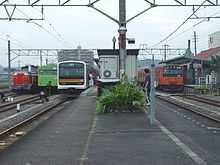Hachikō Line
Hachikō Line | |||
|---|---|---|---|
.jpg) 209 series EMU crossing the Tama River, February 2007 | |||
| Overview | |||
| Type | Heavy rail | ||
| Locale | Tokyo Metropolis, Saitama Prefecture, Gunma Prefecture | ||
| Termini |
Hachiōji Kuragano | ||
| Stations | 23 | ||
| Operation | |||
| Opening | 1931 | ||
| Operator(s) | JR East | ||
| Rolling stock | 205-3000 series, 209-3000 series, 209-3100 series, E233 series, KiHa 110 series | ||
| Technical | |||
| Line length | 92.0 km (57.2 mi) | ||
| No. of tracks | Double-track shared with Takasaki Line (Kita-Fujioka - Kuragano) | ||
| Track gauge | 1,067 mm (3 ft 6 in) | ||
| Electrification | 1,500 V DC overhead catenary (Hachiōji - Komagawa) | ||
| |||
The Hachikō Line (八高線 Hachikō-sen) is a 92.0 km regional railway line owned and operated by East Japan Railway Company (JR East). It is located within Tokyo, Saitama, and Gunma Prefectures in Japan. Its endpoints are Hachiōji Station in Hachiōji, Tokyo and Kuragano Station in Takasaki, Gunma Prefecture.
Services
Komagawa Station in Hidaka, Saitama, divides the line into two distinct sections. The southern section from Hachiōji to Komagawa is electrified at 1,500 V DC. Some trains terminate at Komagawa, while others continue over the Kawagoe Line to Kawagoe Station. A few trains leave the Hachikō Line at Haijima Station, entering the Ōme Line and terminating at Tokyo Station.
The non-electrified northern section connects Komagawa with Kuragano. All trains continue on the Takasaki Line to Takasaki, where transfer to the Jōetsu Shinkansen is available. There are no through services connecting the southern and northern halves of the line.
Japan Freight Railway Company also operates trains on the Hachikō Line.
The Hachikō Line takes the first kanji of its name from the first character of Hachiōji (八王子) and the second kanji from the first character of Takasaki (高崎).
Stations
- All trains stop at every station.
- Stations marked "o" or "^" allow passing; stations marked"|" do not. Stations marked "∥" are double-tracked.
Rolling stock

- 205-3000 series 4-car EMUs x 5 (Kawagoe Line/Hachikō Line services)
- 209-3000 series 4-car EMUs x 4 (Kawagoe Line/Hachikō Line services since March 1996)[1]
- 209-3100 series 4-car EMUs x 2 (Kawagoe Line/Hachikō Line services since 17 April 2005)[1]
- E233 series EMUs (Chūō Line (Rapid) through services between Komagawa and Haijima, from 17 March 2007)
- KiHa 110 series DMUs (formed as 1- to 3-car trains for services north of Komagawa)
Rolling stock previously used
- KiHa 35 DMUs (until March 1996)
- 103-3000 series EMUs (from March 1985 until October 2005)[1]
- 103-3500 series EMU (from March 1996 until March 2005)[1]
- 201 series EMUs (Chūō Line (Rapid) through services between Komagawa and Haijima, until March 2008)
History
Wanman driver only operation commenced on the non-electrified section between Komagawa and Takasaki on 16 March 1996, using KiHa 110 series DMUs.[2]
Accidents
- Hachiko Line derailment in 1947
References
![]() Media related to Hachikō Line at Wikimedia Commons
Media related to Hachikō Line at Wikimedia Commons
| ||||||||||||||||||||||||||||||||
| |||||||||||||||||||

.svg.png)